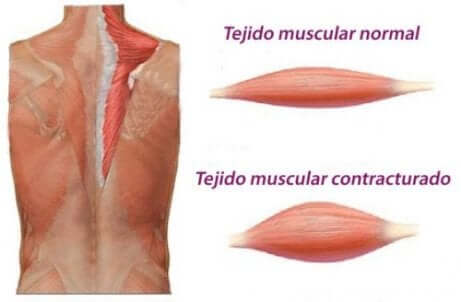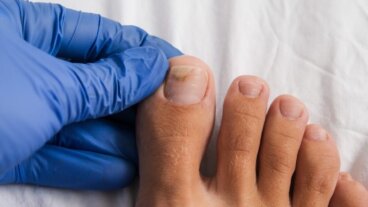5 Tips to Get Rid of Muscle Cramps


Written and verified by the pedagogue in physical education and nutritionist Elisa Morales Lupayante
Muscle cramps or contractures are involuntary contractions of one or muscles in any part of the body, generally located in:
- The neck
- The shoulders
- The lumbar zone, at kidney level
- The dorsal zone, at the shoulder blade level
It can cause immobility in the affected areas, discomfort and pain to those who are suffering from them.
However, getting rid of a muscle contracture is easy if you know the methods to do it.
If you were looking for a way to quickly and effectively get rid of contractures, you will find more than one answer in this article. Don’t miss out!
What exactly are muscle cramps?

In their normal state, muscles contract and then relax. In some cases, however, the muscle can’t relax and it stays tight. A cramp is an involuntary muscle contraction, which results in what many people call a “knot” in your muscles. The area where the knot is stays hard and swollen.
This contraction reduces movement and can be very painful. It can also affect the adjacent muscles, which creates more cramps, and so on. It can be a vicious cycle.
The only way to treat this and alleviate this pain is to release the contraction.
What are the causes of muscle cramps?
Cramps can appear for many reasons, such as such as sedentary lifestyles and sitting or standing in the same position for long periods of time, as well as somatization (derived from stress or anxiety) and the following:
- Trauma.
- Sudden movements.
- Overexertion when trying to do an exercise (without having warmed up before) or lifting a heavy object.
On the other hand, insufficient water intake and an inadequate diet, among other bad lifestyle habits, can contribute to the appearance of various discomforts, including contractures.
It is interesting to know that the deficit of some essential minerals (such as magnesium) is also associated with muscular discomfort.
How to get rid of muscle cramps
While there are specific medications to treat cramps, such as prescription muscle relaxers, there are some things you can try at home to get some relief.
These measures shouldn’t replace medication or your doctor’s recommendations. While they can be effective, they should be a complement to professional treatment.
1. Don’t force the muscle
The first thing that you should do when you have a cramp is to avoid forcing the muscle or affected area. Therefore, try to perform the movements gently and rest as much as possible. In this way, you will avoid causing more damage.
Do this until your muscle is completely recovered. That means avoiding heavy lifting, high-impact physical activities, or any kind of intense muscle exertion.
Be careful, don’t stay completely still either. Extremes are harmful.
2. Stretching

If the doctor has already evaluated you and has indicated which stretches may be the best for you, follow his advice. On the other hand, if you have any queries, consult your physiotherapist.
2. Hot water
Compresses and hot showers can help relieve pain and other discomfort in the event of cramp. They also help to relax the body in general, which is very pleasant.
Therefore, to reduce the discomfort of contracture, you can apply a hot compress for a few minutes, several times a day.
3. Applying rosemary and clay
Just as hot compresses can contribute to relief in case of muscle pain or contracture, some poultices and ointments are also considered to be useful.
An example of this is the mixture of rosemary and clay, to which anti-inflammatory, relaxing and antispasmodic properties are attributed.
Ingredients
- 4 tablespoons of rosemary (50 grams)
- 200 grams of white clay
- 1 glass of water (200 ml)
Preparation
- Pour the water and rosemary into a pot.
- Turn on the stove and boil for 10 minutes.
- Let sit for 20 minutes.
- Move the liquid with the rosemary to a plastic container.
- Add the clay and mix well until there are no lumps.
- Let sit for at least 2 hours.
How to use it
- Apply the mixture directly to the affected area.
- Let sit for 20 minutes.
- Rinse with hot water.
- Repeat twice a day.
For the greatest benefits, we recommend that you apply a natural oil to the area after taking off the mixture. It’s important not to use any metal objects while preparing the mixture because that can affect the clay’s properties.
5. Chamomile

Another remedy that can help you in case of contracture or muscle discomfort is the classic chamomile infusion. It has anti-inflammatory, antispasmodic, relaxing and slightly sedative properties.
Be careful, chamomile tea alone will not eliminate the pain of the contracture, but it can contribute to the relief and relaxation of the body. Drink it with a bit of honey if you wish or a few drops of lemon juice.
How to avoid muscle cramps
To avoid contractures, it is recommended that you introduce new habits on a daily basis. Here are some of the most important ones:
- Avoid overexerting the muscle, and rest if your muscles are tired.
- Exercise regularly and always warm-up and stretch.
- Have good posture always, and not only when doing exercise or playing sport.
- Eat a balanced diet.
- Drink enough water.
- Try to manage your thoughts and emotions to avoid somatizations in the back and other areas of the body.
If you think you have a contracture or any other similar problem, consult your doctor and follow his or her instructions. You may also consider seeing a physical therapist.
All cited sources were thoroughly reviewed by our team to ensure their quality, reliability, currency, and validity. The bibliography of this article was considered reliable and of academic or scientific accuracy.
- Sagorchev, P., Lukanov, J., & Beer, A. M. (2010). Investigations into the specific effects of rosemary oil at the receptor level. Phytomedicine. https://doi.org/10.1016/j.phymed.2009.09.012
- https://www.fisioterapia-online.com/articulos/nudos-en-la-espalda-contracturas-musculares-que-son
This text is provided for informational purposes only and does not replace consultation with a professional. If in doubt, consult your specialist.








